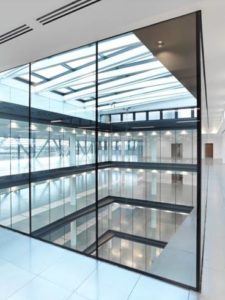Fire Protective and Fire Resistive: What’s the Difference?
 They sound virtually the same so you can understand why most people – even in the construction industry assume they are synonymous, but fire protection and fire resistance refer to two separate performance criteria set forth by the International Building Code (IBC). These two categories have their own unique requirements related to test standards, applications and performance traits. Fire protection is what most people are familiar with who understand fire ratings. This type of material can be installed as a window rated up to 45 minutes, or beyond that as part of a door vision panel. Fire protection is subject to NFPA 252 and 257, and UL 9, 10B and 10C which all relate to fire protective door and window assemblies. The key attributes to fire protection is that it will contain smoke and flame up to 45 minutes (or beyond in limited sizes as part of a vision panel in a door assembly) and cannot exceed 25% of the total wall area due to its inability to block the transmission of radiant heat.
They sound virtually the same so you can understand why most people – even in the construction industry assume they are synonymous, but fire protection and fire resistance refer to two separate performance criteria set forth by the International Building Code (IBC). These two categories have their own unique requirements related to test standards, applications and performance traits. Fire protection is what most people are familiar with who understand fire ratings. This type of material can be installed as a window rated up to 45 minutes, or beyond that as part of a door vision panel. Fire protection is subject to NFPA 252 and 257, and UL 9, 10B and 10C which all relate to fire protective door and window assemblies. The key attributes to fire protection is that it will contain smoke and flame up to 45 minutes (or beyond in limited sizes as part of a vision panel in a door assembly) and cannot exceed 25% of the total wall area due to its inability to block the transmission of radiant heat.
Fire resistive may be used in applications requiring 45 minute rating but is required for 60 minute ratings and above, and isn’t limited to size or application. Similar to fire protective products, fire resistive products will contain smoke and flame. Additionally, fire resistive products are required to block the transmission of radiant heat and must have a 250 degree Fahrenheit temperature rise rating. Fire resistive products must meet ASTM E-119, NFPA 251 and UL 263 standards. These standards differ from those associated with fire protection as they are used to test the construction of a wall, as opposed to an opening in a wall.
The blockage of radiant heat and gases are the key differentiators between fire resistive and fire protective products. This advantage of fire resistive products not only ensures safe egress in the event of a fire, but also will keep combustible materials from igniting due to the high radiant heat. The temperature rise rating of a fire resistive glass and frame assembly is a key performance requirement that is required by code. This makes fire resistive glass and frame assemblies an excellent choice for applications such as large window walls where natural light and daylighting are a key design component.
For more information on fire resistive glazing products and how it differs from fire protective glazing, check out this document and available fire resistive frame products from Ceco Door and Curries.
No comments yet - you can be the first!